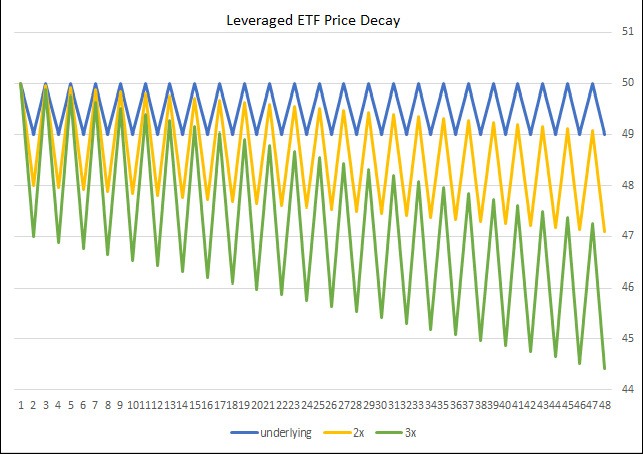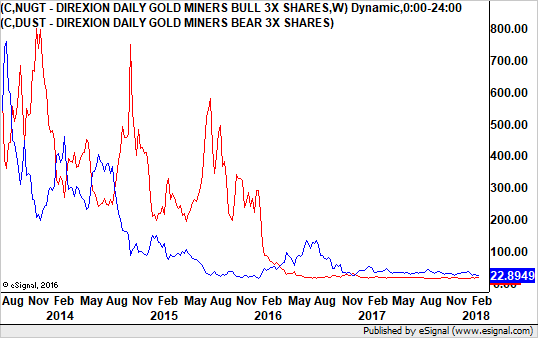Run, Don’t Walk, From Leveraged ETFs
Leveraged ETFs may make exciting moves, but these trading instruments are perilous for most portfolios.

The competition for investor dollars is fierce, and Wall Street is rife with financial geniuses figuring out new products designed to profit from even the most esoteric of trends. Some of them are good. Others could eat you alive.
One truly great idea was the exchange-traded fund (ETF), which allows investors to own a piece of an entire sector of the market, such as banking, the latest hot trend or even the entire market, with one instrument that trades just like a common stock.
Unfortunately, they just cannot leave well enough alone. They have to supercharge it with leverage, which seems to be a way for individual investors to profit with the professionals.
From just $107.88 $24.99 for Kiplinger Personal Finance
Become a smarter, better informed investor. Subscribe from just $107.88 $24.99, plus get up to 4 Special Issues

Sign up for Kiplinger’s Free Newsletters
Profit and prosper with the best of expert advice on investing, taxes, retirement, personal finance and more - straight to your e-mail.
Profit and prosper with the best of expert advice - straight to your e-mail.
But just because one of their newfangled trading products is exciting does not mean it is right for most investors. Indeed, investors often fail to understand that leveraged ETFs cut both ways. Leverage can rev up your profit potential, but at the same time increase your risk of incurring losses.
Again, that is not necessarily bad. Investors already choose their risk/reward preferences in the types of stocks they buy now. There is a difference between the stock of a staid food company, which makes steady but small profits year after year, and a Silicon Valley company that is working on self-driving cars, cloud computing and blockchain technology. The latter has much higher risk but promises the possibility of a huge reward.
However, leveraged ETFs make big promises they cannot keep simply because of the way they are designed.
Through some financial engineering not relevant here, leveraged ETFs deliver a multiple of the underlying index’s or basket’s returns each day. For example, the ProShares Ultra S&P500 (SSO) “seeks daily investment results, before fees and expenses, which correspond to twice the daily performance of the Standard & Poor’s 500 Index.”
In other words, if the S&P 500 moves higher by 0.50% one day, the Ultra ETF moves higher by 1.00%.
So far, not so bad. If the investor believes that the stock market is going to keep going up then this could be a good vehicle to own. Of course, any day that the market goes down, the Ultra ETF will go down by twice the percentage. That’s the tradeoff for the higher profit potential.
But here is the problem, and it is a big one.
Here Comes the Math
The value of a leveraged ETF is recalculated every day. Let’s say a regular, non-leveraged ETF currently trades at $50.00 per share and a two-times (or 2x) leveraged ETF, based on the same underlying basket, coincidently also trades at $50.00 per share. The next day, the regular ETF falls by one point to $49.00 per share. That’s a 2% loss.
The 2x leveraged ETF falls by 4% to a price of $48.00 per share. No surprise here.
On the second day, the regular ETF rallies back one point to $50.00. Does the 2x leveraged ETF rally back two points? No, it does not. The math says that the regular ETF gained 2.04%. Therefore, the 2x ETF gained 4.08%. Again, that looks good until you realize that a 4.08% gain on an ETF trading at $48.00 results in a price of $49.96. It does not rally back to $50.00, as the regular ETF did.
Why? Because what matters are percentages, not points. To recoup a loss in the stock market, the percentage required to gain is higher than the original percentage lost.
Here is the simplest example. If the S&P 500 loses 50% in a bear market, it must double to get back to breakeven. That is a needed gain of 100%. If it only gains back 50% – the same percentage it lost – it still will be in bear-market territory.
Over time, even if the underlying fund stays in a flat trading range, leveraged ETFs can lose money. That is why they are only for short-term strategies for traders.
The chart below shows idealized paths for a regular ETF, a 2x ETF and a 3x ETF when the underlying simply moves down by one point and then up by one point day after day.

And the same is true for inverse leveraged ETFs, which are designed to move two or three times the daily change in the underlying but in the opposite direction.
Making them even less attractive, the higher the volatility of the underlying market, the worse the capital decay becomes.
To be sure, if you pick a leveraged ETF and the underlying market moves strongly in the direction you wanted then you can indeed make a beefy profit. But even in this scenario, high volatility can still be a huge drag on profitability.
The No-Risk Profit?
There is no such thing as a no-risk profit, but given the natural value decay of leveraged ETFs, selling them short is a good plan, right? If it were that easy, of course, Wall Street would have already figured that out; sell both the leveraged long and inverse versions of an ETF, kick back and watch the profits roll in. That’s the dream anyway and it works sometimes.
A chart of the Direxion Daily Gold Miners Bull 3x Shares ETF (NUGT) and the Direxion Daily Gold Miners Bear 3x ETF (DUST) shows that both ETFs lost plenty of their value over time.

Gold mining stocks saw many short-term up and down cycles over the past few years. Both ETFs lost money.
Now let’s look at an underlying market that was in full rally mode with low volatility. It is no surprise that the Proshares Ultrashort S&P 500 ETF (SDS), a 2x leveraged inverse ETF, plunged in 2017, losing 32.08% of its value. However, the SSO gained 43.72%, which was better than twice the performance of the S&P 500 and its 19.42% gain.
Had you been short each S&P 500 leveraged ETF, you would have gained only 11.68% before commissions. And that does not take into account margin fees and possibly even margin calls.
Before calling your broker to capture what appears to be a risk-free, albeit a relatively modest gain, consider that the 2017 stock market was extraordinarily good to investors, and extraordinarily calm. It was an exception, not the norm.
In most markets, over time, they will decay in value. So even if you feel you missed out on the great rally of 2017, or if you think a bear market is imminent, leveraged ETFs are very likely to burn a hole in your portfolio.
They can be appropriate for experienced traders who already understand the power of leverage and the time-decay factors involved. If you time them right, a quick trade can be lucrative. But most of us should leave them alone. They are not worth the risk.
Profit and prosper with the best of Kiplinger's advice on investing, taxes, retirement, personal finance and much more. Delivered daily. Enter your email in the box and click Sign Me Up.

-
 I'm want to give my 3 grandkids $5K each for Christmas.
I'm want to give my 3 grandkids $5K each for Christmas.You're comfortably retired and want to give your grandkids a big Christmas check, but their parents are worried they might spend it all. We ask the pros for help.
-
 If You're Not Doing Roth Conversions, You Need to Read This
If You're Not Doing Roth Conversions, You Need to Read ThisRoth conversions and other Roth strategies can be complex, but don't dismiss these tax planning tools outright. They could really work for you and your heirs.
-
 Could Traditional Retirement Expectations Be Killing Us?
Could Traditional Retirement Expectations Be Killing Us?A retirement psychologist makes the case: A fulfilling retirement begins with a blueprint for living, rather than simply the accumulation of a large nest egg.
-
 AI Stocks Lead Nasdaq's 398-Point Nosedive: Stock Market Today
AI Stocks Lead Nasdaq's 398-Point Nosedive: Stock Market TodayThe major stock market indexes do not yet reflect the bullish tendencies of sector rotation and broadening participation.
-
 Dow Adds 646 Points, Hits New Highs: Stock Market Today
Dow Adds 646 Points, Hits New Highs: Stock Market TodayIt was "boom" for the Dow but "bust" for the Nasdaq following a December Fed meeting that was less hawkish than expected.
-
 Dow Rises 497 Points on December Rate Cut: Stock Market Today
Dow Rises 497 Points on December Rate Cut: Stock Market TodayThe basic questions for market participants and policymakers remain the same after a widely expected Fed rate cut.
-
 JPMorgan's Drop Drags on the Dow: Stock Market Today
JPMorgan's Drop Drags on the Dow: Stock Market TodaySmall-cap stocks outperformed Tuesday on expectations that the Fed will cut interest rates on Wednesday.
-
 Stocks Slip to Start Fed Week: Stock Market Today
Stocks Slip to Start Fed Week: Stock Market TodayWhile a rate cut is widely expected this week, uncertainty is building around the Fed's future plans for monetary policy.
-
 Stocks Keep Climbing as Fed Meeting Nears: Stock Market Today
Stocks Keep Climbing as Fed Meeting Nears: Stock Market TodayA stale inflation report and improving consumer sentiment did little to shift expectations for a rate cut next week.
-
 Small Caps Hit a New High on Rate-Cut Hope: Stock Market Today
Small Caps Hit a New High on Rate-Cut Hope: Stock Market TodayOdds for a December rate cut remain high after the latest batch of jobs data, which helped the Russell 2000 outperform today.
-
 UNH Sparks a 408-Point Surge for the Dow: Stock Market Today
UNH Sparks a 408-Point Surge for the Dow: Stock Market TodayThe best available data right now confirm both a slowing employment market and a December rate cut, a tension reflected at the equity index level.